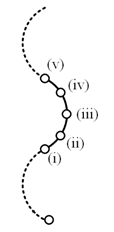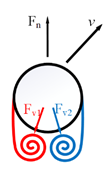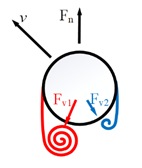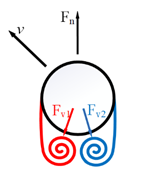Abstract
When a bubble rises freely in still water, it often moves along a zigzag or spiral trajectory. In order to explore the mechanism of this movement, an experiment was conducted to record the changes in the movement trajectory and bubble shape. The results show that this movement can be explained by the swing of trailing vortices and the change in vorticity. There is asymmetric shedding of the trailing vortices. The change in bubble velocity caused by the shedding of the bubble trailing vortices will lead to an asymmetric change in the vorticity of the trailing vortices. Two factors lead to an asymmetric change in the drag force of the trailing vortices on both sides of the bubble, resulting in the zigzag trajectory. Only when the aspect ratio λ reaches 2.0 will the bubble move along the zigzag. The trailing vortices moving in two orthogonal directions will lead to a spiral trajectory. The movement of the trailing vortices not only changes the trajectory of the bubble but also changes its shape. The effect of the trailing vortices on the bubble can be equivalent to a low-pressure area around a bubble. When a bubble moves along a zigzag trajectory, the low-pressure area at the trailing of a bubble swings back and forth in a plane, and the bubble is flatter. When moving along a spiral trajectory, the low-pressure area rotates around the trailing of the bubble and becomes more spherical. Compared with a zigzag trajectory, a bubble has a higher velocity and lower frequency when moving along a spiral trajectory.
1. Introduction
Flow around bluff bodies (sphere, disk, etc.) exists widely in natural phenomena and industrial production processes. When fluid flows around a bluff body, flow separation will occur on the boundary of the bluff body, and a wake will be generated at the rear of the bluff body, accompanied by vortex shedding. Many studies have explored the shape of the wake when flowing around a stationary sphere through experiments and numerical simulations [1,2,3]. With an increase in Re, the shape of the wake transits from an axisymmetric stationary ring structure to two parallel counter-rotating vortices, then to a periodically shedding hairpin vortex, and finally, to a turbulent state. At the final stage, the vortex separation point may also rotate around the sphere [4]. Magnaudet [5] simulated the flow around a fixed spheroidal bubble and found that the vorticity was proportional to Re0.5 when Re was large without slip boundary conditions. The unsteady movement of the wake comes from the small disturbance, and the greater the Re, the more the instability inherent in the wake will enhance the disturbance, resulting in more complex wake motion [6]. Deng [7] explored vortex-induced vibration when flowing around a cylinder at a low Re through a numerical simulation and found the influence of the alternately oscillating trailing vortices on the lift and drag coefficients of the cylinder but did not consider the influence of the forced cylinder on the wake movement.
The instability of the wake will directly lead to instability in the movement [5,8,9,10]. When bubbles rise in still water, there is an abnormal phenomenon, that is, they rise along a zigzag or spiral trajectory [11,12], which is related to the periodic oscillation of the Karman vortex street. This trajectory is not directly generated by the movement of the wake under the corresponding Re but is generated by the close coupling between the movement of the wake and the oscillating trajectory. The trajectory also affects the shedding of the trailing vortices, which together leads to the bubble movement [9,10]. At present, bubble flow plays an important role in a wide range of geophysical and industrial processes, including two-phase heat exchangers, oil transportation, mixing in chemical reactors, nuclear reactor cooling, and alloy refining [13]. In the metallurgical process, bubbles are injected into the liquid metal to promote liquid movement, homogenize the physical and chemical properties of the melt, and refine the melt [14]. In industrial reaction catalysis, buoyant particles or bubbles are usually released to enhance mixing in the fluid [15,16]. Therefore, research on bubble flow is significant for guiding engineering practices scientifically.
Gu [17] simulated the free rising process of bubbles in still water by the VOF (volume of fluid) method and found that the wake of bubbles presents three movement states: symmetrical falling, a transitional state, and periodic falling. The two critical Re values increase with an increase in the bubble diameter, and the bubble frequency of zigzag movement decreases with an increase in the bubble diameter. He [18] simulated the rising process of a single bubble under buoyancy by the Level Set method to explore the influence of the initial shape on the bubble movement and shape. The simulation results show that the final shape and rising velocity of the bubble are determined by the Eötvös number Eo and the Morton number Mo. The Eo can be considered as the ratio of buoyancy to surface tension. The Mo can be considered as the ratio of viscous force to tension. They can be used to describe the appearance of bubbles or water droplets as they move in a fluid or continuous phase.
where represents gravitational acceleration. represents the density difference between the two fluids. represents the characteristic length. and represent the dynamic viscosity and density of the surrounding fluid, respectively. represents the surface tension. When Eo < 52, the shape of bubbles are not affected by the initial shape. At a high Eo and low Mo, the final shape of the bubble is dominated by the initial shape, showing a spherical cap shape and a ring shape. The larger the initial aspect ratio is, the easier it is for bubbles to develop into rings and the stronger the fluctuation in the rising velocity is. Zhang [19] revealed that the accumulated streamwise vorticity on the bubble interface is the reason for the triggering of zigzag movement through a direct numerical simulation (DNS). Chen [20,21] simulated the rising process of a single bubble in still water without a boundary and near to the vertical wall and found that the inhibition of the flow around the bubble by the wall is why the wall exerts a force on the bubble, causing the bubble to move away from the vertical wall. Bintein [10] blew droplets onto the fiber with a crosswind and found that the droplets moved back and forth horizontally. When two droplets are moving towards each other, they will bounce back before they touch, which further proves that the wake vortex has a strong influence on the movement of the liquid droplets. However, the droplets are bound to the fiber, and their vertical trajectory cannot be studied. Xu [22] used high-speed photography to analyze the movement of bubbles under stable conditions and found that when the bubble diameter d < 1mm, it can be regarded as a stable rigid ball. When d < 3 mm, there are spiral vortices at the tail of the bubble, which conforms to the law of the Karman vortex. When d > 3 mm, the bubble moves in an ellipsoidal shape, and its shape changes all the time. The rotation period becomes shorter and no longer conforms to the law of the Karman vortex. Zuo [23] used the two-dimensional PIV method to analyze the zigzag movement of bubbles in water and found that there was phase coupling among the fluctuation, movement trajectory, and the wake of the bubble. According to the vortex criterion theory, he found alternating shedding of vortex rings and left and right asymmetry in flow transport. He explained the reason for the zigzag movement in the horizontal direction from the perspective of force according to the vortex shedding mechanism, but the oscillation of the bubble velocity in the vertical direction was ignored.
In this study, we observed the movement process and shape change of bubbles rising in water through experiments and explored the movement rules of bubbles in both horizontal and vertical directions as well as the characteristics of vortex oscillation. On the basis of previous studies, we explored the mechanism of bubble movement from the perspective of force.
2. Experimental Equipment and Method
The experimental equipment is shown in Figure 1. The container was a 10 cm × 10 cm × 20 cm square columnar tank with distilled water. During the experiment, the flat needle of the syringe was fixed in the center of the tank bottom, with the outlet facing up. The needle and the syringe filled with air were connected with a rubber hose, so that the syringe could be controlled outside the water tank to produce a single bubble. Different bubbles were produced by using needles with different inner diameters. Two cameras (Nikon D7100) were used to take pictures from two orthogonal directions with the shadow method, and the speed was 120 frames per second. Finally, Tracker software was used to track the bubble’s position and size over time.
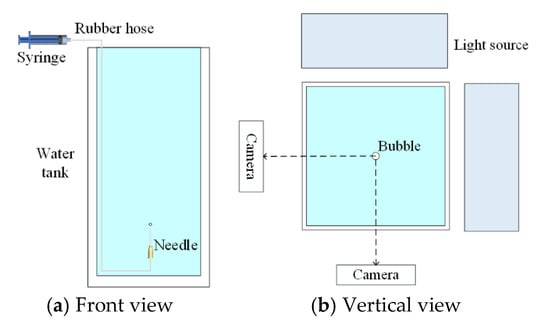
Figure 1.
Diagrammatic drawing of the experimental device.
The initial diameter is represented by the equivalent diameter of the bubble when it leaves the needle, as shown in Figure 2, while the instantaneous diameter is represented by the instantaneous equivalent diameter of the side view ellipse. The calculation method for the equivalent diameter is shown in Formula (3).
where S is the effective area, A is the wetted perimeter, and a and b are the major and minor axes of the ellipse.
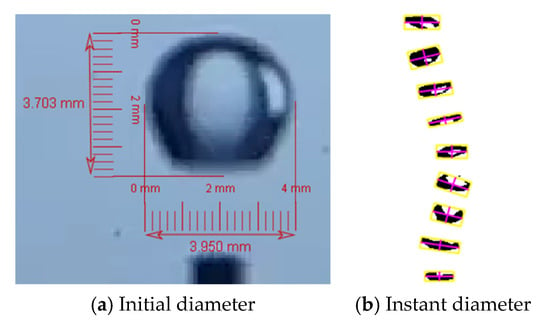
Figure 2.
Measurement of the (a) initial and (b) instant equivalent diameter of the rising bubble.
3. Results and Discussion
The bubble starts to move upward after it leaves the needle. At the beginning, it moves vertically and upwards in a straight trajectory. After rising for a distance, the movement becomes unstable and begins to deflect. It swings left and right along a zigzag trajectory or spiral trajectory, as shown in Figure 3. This rising track violates human intuition, and this paper gradually analyzes its mechanism.
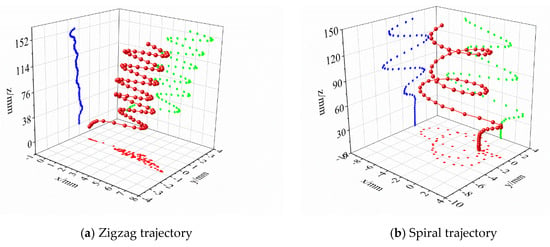
Figure 3.
Trajectory of the bubble in water.
3.1. Vertical Movement
3.1.1. Deformation of the Bubble
When a bubble rises, its shape tends to flatten as a whole under the combined action of the stagnation pressure of the fluid on its upstream surface, the negative pressure of the side flow, the negative pressure of the downstream surface, and the internal surface tension of the bubble. Cano Lozano J C [24] found that, for a sufficiently large Re ( = 240~470), the flow of asymmetric bubbles with flat fronts and curved backs is more stable than that of spherical bubbles. The larger the bubble size is, the smaller the internal pressure caused by its surface tension is, and thus, the greater the deformation is, as shown in Figure 4.
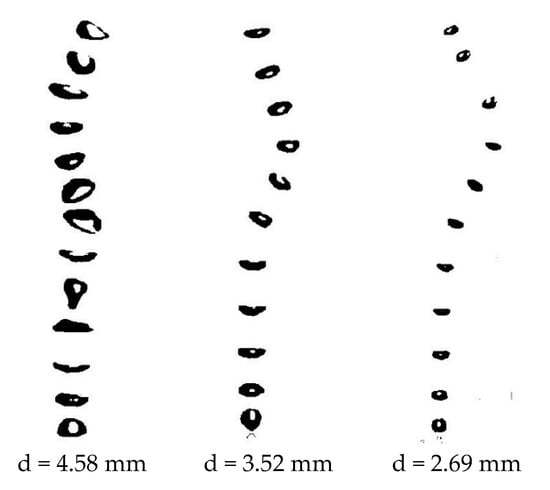
Figure 4.
Changes in bubble shapes with different diameters.
3.1.2. Effect of Bubble Deformation
Figure 5 shows the aspect ratio of the transition point where the bubble changes from vertical to zigzag motion, which is above 2.0. The larger the bubble diameter is, the larger the change range of the aspect ratio of the transition point is. This is caused by the fact that the larger the bubble diameter, the greater the deformation degree. The flow around bubbles is different from that of solid spheres. The liquid film on the bubble surface can slide freely, and the free slip boundary condition will be formed at the junction of the two-phase flow. When the fluid flows around the bubble, it is difficult to produce flow separation at its tail. Through direct vertical simulation of flat bubbles, Magnaudet [5] found that there is a critical value for the instability of the bubble wake, that is, an aspect ratio λ of 2.21. Only when the aspect ratio λ is greater than 2.21 can the vorticity brought about by the nonshear flow make the wake flow unstable, and the larger the aspect ratio λ, the wider the range that can cause wake instability. The critical value of the aspect ratio in this experiment is about 2.0, which is close to the simulation result.

Figure 5.
Aspect ratio of the transition point.
3.2. Zigzag Movement
3.2.1. Movement Characteristics of Zigzag Movement
After the vertical movement, the bubble begins to deflect, and a zigzag trajectory occurs. Figure 6 shows the change curve and frequency spectrum of the displacement, velocity, and acceleration of zigzag movement. The x-direction is the horizontal direction, and the z-direction is the rising direction. u and w are the velocity in the x-direction and the z-direction, respectively, and q is the resultant velocity. In the zigzag movement stage, the bubble movement has the following characteristics:
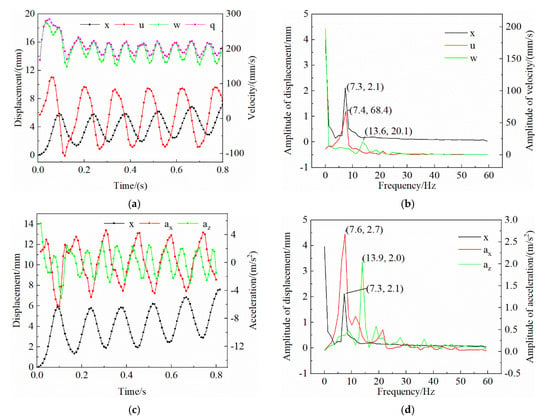
Figure 6.
Zigzag movement law of bubbles. (a) Changes in displacement and velocity over time. (b) Displacement and velocity frequency spectrum analysis diagram. (c) Changes in displacement and acceleration over time. (d) Displacement and acceleration frequency spectrum analysis diagram.
(1) The velocities and accelerations in the x- and z-directions oscillate over time.
(2) The frequencies of velocity and acceleration in the x-direction are consistent with the frequency of the trajectory, and the frequencies of velocity and acceleration in the z-direction are about twice the frequency of the trajectory.
(3) The velocity in the z-direction is much higher than that in the x-direction, and its change trend is consistent with the resultant velocity.
(4) The movement law of the bubble can be concluded when the bubble moves from a middle point to the next middle point. This is exactly half a cycle. In the x-direction, in the first 1/4 cycle, the bubble decelerates with a reversely increased acceleration. In the last 1/4 cycle, the bubble accelerates with a reversely decreased acceleration. In the z-direction, in the first 1/4 cycle, the bubble accelerates with the acceleration first increasing and then decreasing, and in the last 1/4 cycle, the bubble decelerates with the acceleration first increasing and then decreasing. The acceleration directions are different in the two 1/4 cycles.
3.2.2. Movement Mechanism of Zigzag Movement
The movement of the bubble is related to the surrounding fluid, and its acceleration can relatively reflect the force. Bubbles are mainly subject to buoyancy and the tractive force of the vortices at the tail of the bubble, as shown in Table 1. The edge velocity v of the vortex is about equal to the incoming velocity (bubble rising velocity). According to the Bernoulli equation, the pressure at the edge of the vortex can be obtained [25].

Table 1.
Force diagram of the half periodic movement of the zigzag trajectory of a bubble.
The higher the incoming flow velocity, the lower the pressure at the vortex edge, and the greater the tractive force on the bubble. The flow inside the vortex is not discussed here, because it cannot directly affect the movement of bubbles. The buoyancy
is related to the bubble volume. Air is compressible, and its compressibility is related to Ma (Mach number). When Ma < 0.3, air can be regarded as incompressible [26]. Therefore, the buoyancy is unchanged.
It can be seen from Figure 6 that the bubble velocity oscillates within a range, without monotonic change, that is, the and of the bubble reach a dynamic balance. Table 1 shows the change in the trailing vortices in half a period of bubble movement (the movement trajectory is the bold part of the solid trajectory line in Table 1). The right side is the positive direction of the x-axis, and the upper side is the positive direction of the z-axis. The force analysis is shown in Table 1, where represents the resultant force and represents the resultant velocity. Throughout the whole process, the bubble always maintains a vertical upward velocity.
During zigzag motion, the force on the bubble is in a dynamic equilibrium state. When the bubble moves to the midpoint of the oscillation, the buoyancy Fn and the traction force Fv of the two vortices on the bubble reaches equilibrium, and at this time, the bubble velocity is towards the upper right. Subsequently, the bubble moves to the right, causing the vortex on the right to fall off and Fv2 to rapidly decrease. The bubble is subjected to a combined force towards the upper left. The horizontal velocity u decreases and the vertical velocity w increases. Because the vertical velocity determines the overall velocity of the bubble, the overall velocity q of the bubble gradually increases, and the vortex strength on the left side of the bubble increases. According to the Bernoulli equation, Fv1 gradually increases, and the resultant force of the bubble rotates counterclockwise until it reaches the right endpoint. At this point, the direction of the resultant force is to the left, and the bubble velocity is at its maximum, and the direction is upward. Subsequently, the bubbles move to the left, the vortices on the right regenerate, Fv2 increases, and the combined force of the bubbles faces the lower left. The horizontal velocity u increases, the vertical velocity w decreases, and the overall velocity q of the bubble decreases. The left vortex strength decreases. According to the Bernoulli equation, Fv1 gradually decreases until the bubble returns to the midpoint of the oscillation, and the force is balanced. At this point, the bubble has a velocity towards the upper left. The bubble moving in the opposite direction also has the same change rule. In short, the shedding of the vortex on one side and the change in vortex strength on the other side lead to the zigzag motion rule of bubble formation.
Zuo [23] found, through the PIV method, that when the zigzag oscillation of a bubble rises, the tail vortex swings left and right with it. The center of the vortex core is a low-pressure region that generates forces on both sides of the bubble in the x-direction, resulting in zigzag oscillation. On the basis of the oscillation of the wake vortex, this article adopts the viewpoint that negative pressure is generated by the flow at the edge of the wake vortex, and negative pressure generates traction force on the bubble. Furthermore, it fully explains the changes in force on the bubble from both the x- and z-directions. The article proves that the zigzag motion of bubbles is not solely caused by the wake vortex, but rather, by the mutual coupling of the wake vortex and bubble motion.
3.2.3. Characteristics of Wake Movement
In the zigzag movement stage, the frequency decreases with an increase in diameter. The dimensionless Strouhal number Sr is used to characterize the frequency of motion. Its definition is as follows.
where and are the average velocity and equivalent diameter of the zigzag movement process. According to Formula (5), the Sr of the zigzag movement of bubbles is about 0.055, as shown in Figure 7. The frequency of the trajectory is that of wake vortices. Tomboulides [27] conducted a numerical simulation of the flow around a viscous incompressible sphere and found that under the same Re condition as used in this study, the Sr of the wake oscillation behind the sphere was about 0.195, which is greater than the bubble wake oscillation frequency, indicating that when the trailing vortices drive the bubble to undergo zigzag movement, the oscillation frequency of the wake itself is also hindered.
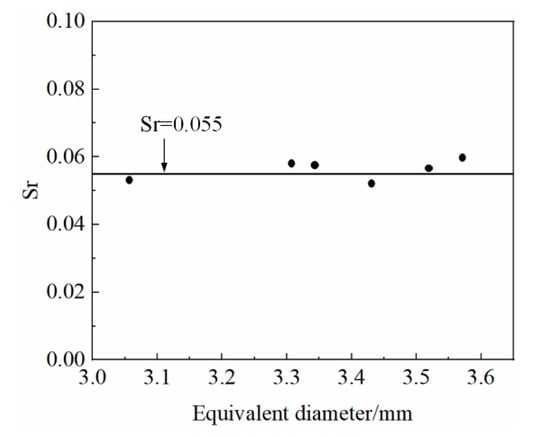
Figure 7.
Relationship between the frequency and diameter of bubbles during zigzag movement.
3.3. Spiral Movement
3.3.1. Several Trajectories of Bubble Movement
In addition to the zigzag trajectory, the movement of bubbles in water may move into the third dimension. There are several kinds of bubble movement trajectories in Figure 8.
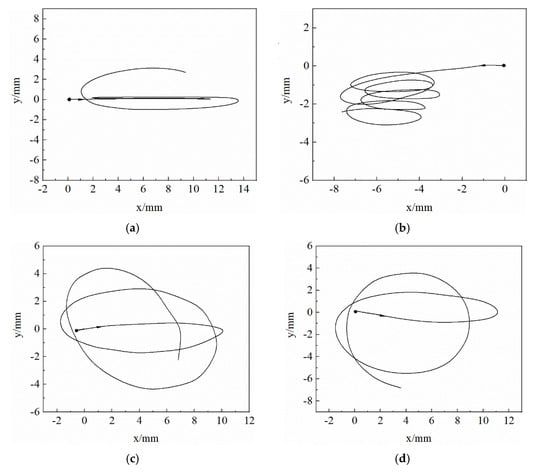
Figure 8.
Several trajectories of bubbles. (a) Transition from a zigzag to an elliptical trajectory. (b) Elliptical trajectory. (c) Elliptical trajectory with a change in the major axis direction. (d) Transition from an elliptical to a spiral trajectory.
3.3.2. Characteristics of Spiral Movement
Figure 9 shows the change curve and the frequency spectrum of displacement, velocity, and acceleration in x-, y-, and z-directions during the process of a bubble’s trajectory developing from vertical to zigzag and finally to spiral. After 0.1 s, the bubble’s trajectory changes from vertical to zigzag. After 0.35 s, it develops into a relatively standard spiral. In the spiral movement stage, the trajectory in the x- and y-directions differs by 1/4 cycle. The frequencies of the displacement and velocity oscillation in the x- and y-directions are close to each other. The velocity in the z-direction does not oscillate, and the frequency of acceleration in the z-direction is about 4 times the frequencies in the x- and y-directions.
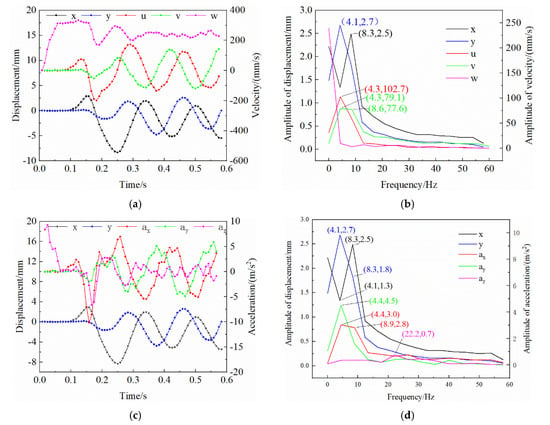
Figure 9.
Spiral movement law of bubbles. (a) Changes in displacement and velocity over time. (b) Displacement and velocity spectrum analysis diagram. (c) Changes in displacement and acceleration over time. (d) Displacement and acceleration spectrum analysis diagram.
According to the zigzag movement mechanism, the change in the bubble trajectory is due to the shedding of the trailing vortices and the change in the tractive force at the tail of the bubble. The asymmetric change in the trailing vortices on the left and right sides of a plane causes an asymmetric force on the left and right sides of the bubble, resulting in zigzag movement. The velocity of the spiral movement is in the range of the velocity oscillation during zigzag movement, so the asymmetric shedding mode of the wake vortices does not change. A disturbance in the direction perpendicular to the zigzag movement plane of the bubble will also cause zigzag movement in this plane, and then this will develop in the third direction (y-direction) to form three-dimensional spiral movement.
At the same time, the trailing vortices of zigzag movement fall off once in a half cycle, while the oscillating movement in the x- and y-directions differs by 1/4 cycle, which proves that the trailing vortices of spiral movement fall off once per 1/4 cycle, that is, the vortex shedding point rotates along the tail of the bubble. At the same time, the staggered shedding of trailing vortices in the orthogonal directions causes the oscillation frequency of acceleration in the z-direction to be 4 times that in the x- and y-directions in a movement cycle.
In the process of bubble movement, due to various factors, such as the bubble shape, the changes in the trailing vortices in the x and y planes are not completely identical, which leads to a variety of bubble trajectories, as shown in Figure 8.
3.3.3. Characteristics of the Wake of Spiral Movement
The frequency law of the spiral movement of bubbles can still be expressed by Sr, which is about 0.03–0.04, as shown in Figure 10. Compared with the zigzag movement, the oscillation frequency of the spiral movement decreases due to the shedding of another group of trailing vortices in a cycle.
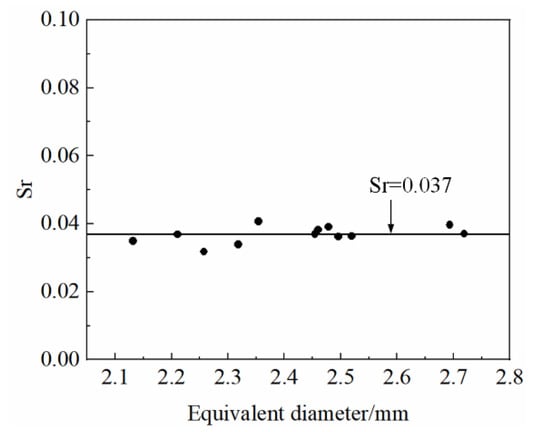
Figure 10.
Relationship between the frequency and diameter during the spiral movement of bubbles.
3.4. Comparison of Zigzag and Spiral Movements
3.4.1. Shape of Bubble
Figure 11 shows the xoy plane trajectory of the bubble from zigzag to spiral and the change curve of the aspect ratio of the bubble in two orthogonal planes. Points of the same color represent the same time. When the bubble’s trajectory changes from a two-dimensional zigzag to a three-dimensional spiral, the size of the aspect ratio and its oscillation amplitude decrease gradually.

Figure 11.
The change in the aspect ratio when the bubble’s trajectory develops from zigzag to spiral.
It can be seen from Figure 11 that the bubble is flatter when moving along the zigzag trajectory and more spherical when moving along the spiral trajectory. The effect of the trailing vortices on the bubble can be equivalent to a low-pressure area around the tail of the bubble. Figure 12 shows the movement of the low-pressure area at the tail of the bubble, where the point represents the low-pressure area. The moving trajectory of the low-pressure area will change the sphericity of the bubble. When moving along a zigzag trajectory, the low-pressure area at the trailing of the bubble swings back and forth in a plane, making the shape of the bubble flatter. When bubble moves along a spiral trajectory, the low-pressure area rotates around the trailing of the bubble, and the shape of bubble is more spherical. In short, the change in the bubble shape is the result of the bubble adapting to the flow.
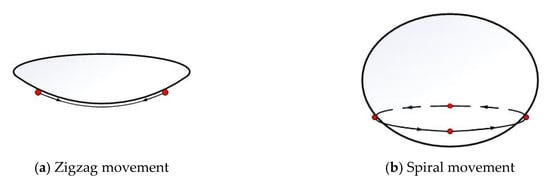
Figure 12.
Movement of the low-pressure area at the trailing of the bubble.
3.4.2. Velocity of the Bubble
Figure 13 shows the velocity change during zigzag and spiral movements of bubbles with diameters of 3.5 mm. The velocity of spiral movement is significantly higher than that of zigzag movement. In general, the zigzag movement of the bubble will eventually change into spiral movement, which proves that the wake movement will gradually cause the bubble to develop into a higher velocity movement mode.
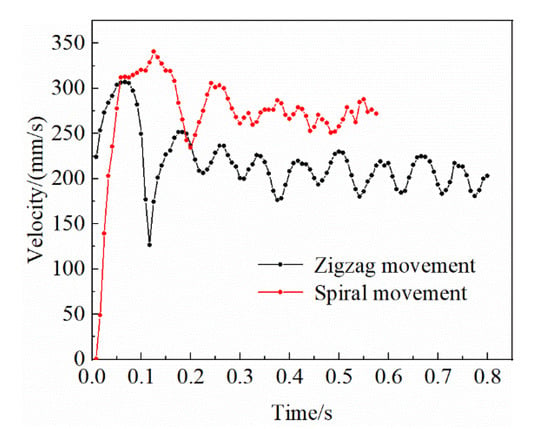
Figure 13.
Velocity comparison between zigzag and spiral movements of bubbles.
4. Conclusions
Bubble flow is widely used in industrial processes, such as the release of bubbles in a fluid to enhance turbulence, unify fluid properties, or cover the bottom of a ship to reduce forward resistance. This paper explored the shape change and movement characteristics of bubbles in water through experiments, found different movement trajectories for bubbles, and coupled the trajectory and wake movement to study the movement mechanism. The detailed conclusions are as follows:
- (1)
- Only when the aspect ratio λ reaches a critical value can the vorticity brought by the flow make the wake flow unstable and then cause the bubble to move along the zigzag trajectory. The value in this experiment was 2.0.
- (2)
- When the bubble moves along the zigzag trajectory, it achieves dynamic equilibrium under the combined action of buoyancy and the tractive force of the trailing vortices. The shedding of the trailing vortices and the change in tractive force at the tail of the bubble cause bubble oscillation.
- (3)
- The zigzag movement of the bubble will also extend in the third direction, forming spiral movement. At this time, the low-pressure area rotates around the trailing of the bubble.
- (4)
- When the trailing vortices cause the trajectory to deflect, its oscillation frequency will also be hindered. The oscillation frequency of zigzag movement is lower than that of the wake of flow around a stationary sphere. The spiral movement causes the shedding of another group of trailing vortices, and its oscillation frequency is lower.
- (5)
- Under different movement trajectories of a bubble, the movement trajectory of the trailing low-pressure area will affect the bubble’s shape. When moving along a zigzag trajectory, the low-pressure area at the trailing of the bubble swings back and forth in a plane, and the bubble is flatter. When moving along a spiral trajectory, the low-pressure area rotates around the trailing of the bubble, and the bubble is more spherical. This is the result of the bubble adapting to the flow.
- (6)
- Compared with zigzag movement, the velocity of the bubble during spiral movement is higher.
Focusing on the macroscopic force, this paper coupled the bubble trajectory with the trailing vortices and reasonably explained the zigzag and spiral movements of the bubble. In essence, the zigzag and spiral rising trajectories of a bubble in water are the result of the bubble adapting to the flow field.
Author Contributions
Conceptualization, Y.W.; Formal analysis, Y.Z.; Funding acquisition, Y.W.; Methodology, Z.M.; Project administration, Y.W.; Software, H.L.; Supervision, Y.Y.; Validation, Y.Z. and M.S.F.; Visualization, Y.Y.; Writing—original draft, H.L. and Z.M. All authors have read and agreed to the published version of the manuscript.
Funding
The work conducted at Xi’an Jiaotong University was supported by the National Natural Science Foundation of China (Grant Nos. 52176128).
Institutional Review Board Statement
Not applicable.
Informed Consent Statement
Not applicable.
Data Availability Statement
The data presented in this study are available upon request from the corresponding author.
Conflicts of Interest
The authors declare no conflict of interest.
References
- Sakamoto, H.; Haniu, H. A Study on Vortex Shedding from Spheres in a Uniform Flow. J. Fluids Eng. 1990, 112, 386–392. [Google Scholar] [CrossRef]
- Stewart, B.E.; Thompson, M.C.; Leweke, T.; Hourigan, K. Numerical and experimental studies of the rolling sphere wake. J. Fluid Mech. 2010, 643, 137–162. [Google Scholar] [CrossRef]
- Prządka, A.; Miedzik, J.; Gumowski, K.; Goujon-Durand, S.; Wesfreid, J.E. The wake behind the sphere; analysis of vortices during transition from steadiness to unsteadiness. Arch. Mech. 2008, 60, 467–474. [Google Scholar]
- Achenbach, E. Vortex Shedding from Spheres. J. Fluid Mech. 1974, 62, 209–221. [Google Scholar] [CrossRef]
- Magnaudet, J.; Mougin, G. Wake instability of a fixed spheroidal bubble. J. Fluid Mech. 2007, 572, 311–337. [Google Scholar] [CrossRef]
- Mittal, R.; Najjar, F.M. Vortex Dynamics in the Sphere Wake. In Proceedings of the 30th Fluid Dynamics Conference, Norfolk, VA, USA, 28 June–1 July 1999. [Google Scholar]
- Deng, Y. Study on Forced Oscillation and Vortex-Induced Vibration (VIV) of Circular Cylinder under Combined Uniform Flow and Oscillatory Flow at Low Reynolds Number. Ph.D. Thesis, Ocean University of China, Qingdao, China, 2014. [Google Scholar]
- Mougin, G.; Magnaudet, J. Path instability of a rising bubble. Phys. Rev. Lett. 2002, 88, 014502. [Google Scholar] [CrossRef]
- Ern, P.; Risso, F.; Fabre, D.; Magnaudet, J. Wake-Induced Oscillatory Paths of Bodies Freely Rising or Falling in Fluids. Annu. Rev. Fluid Mech. 2012, 44, 97–121. [Google Scholar] [CrossRef]
- Bintein, P.-B.; Bense, H.; Clanet, C.; Quéré, D. Self-propelling droplets on fibres subject to a crosswind. Nat. Phys. 2019, 15, 1027–1032. [Google Scholar] [CrossRef]
- Brucker, C. Structure and dynamics of the wake of bubbles and its relevance for bubble interaction. Phys. Fluids 1999, 11, 1781–1796. [Google Scholar] [CrossRef]
- Ellingsene, K.; Risso, F. On the rise of an ellipsoidal bubble in water: Oscillatory paths and liquid-induced velocity. J. Fluid Mech. 2001, 440, 235–268. [Google Scholar] [CrossRef]
- Magnaudet, J.; Eames, I. The Motion of High-Reynolds-Number Bubbles in Inhomogeneous Flows. Annu. Rev. Fluid Mech. 2000, 32, 659–708. [Google Scholar] [CrossRef]
- Zhang, C.; Eckert, S.; Gerbeth, G. Experimental study of single bubble motion in a liquid metal column exposed to a DC magnetic field. Int. J. Multiph. Flow 2005, 31, 824–842. [Google Scholar] [CrossRef]
- Mathai, V.; Huisman, S.G.; Sun, C.; Lohse, D.; Bourgoin, M. Enhanced dispersion of big bubbles in turbulence. arXiv 2018, arXiv:1801.05461v1. [Google Scholar]
- Alméras, E.; Risso, F.; Roig, V.; Cazin, S.; Plais, C.; Augier, F. Mixing by bubble-induced turbulence. J. Fluid Mech. 2015, 776, 458–474. [Google Scholar] [CrossRef]
- Gu, Y.J.; Yang, W.D.; Liu, Z.Y.; Luo, Z.G.; Zou, Z.S. Numerical simulation about evolution of bubble wake during bubble rising by VOF method. CIESC J. 2021, 72, 1947–1955. [Google Scholar]
- He, D.; Li, Y.P.; Liu, Y.Y. Effect of Initial Bubble Shape on Dynamics of a Buoyancy-Driven Bubble. J. Xi’an Jiaotong Univ. 2011, 45, 43–47. [Google Scholar]
- Jie, Z.; Ni, M.J. What happens to the vortex structures when the rising bubble transits from zigzag to spiral. J. Fluid Mech. 2017, 828, 353–373. [Google Scholar]
- Bin, C. Direct Numerical Simulation of a Single Bubble Rising in High Viscosity Fluid. In Multiphase Flow Academic Conference of the Annual Meeting of the Chinese Society of Engineering Thermophysics; Chinese Society of Engineering Thermophysics: Beijing, China, 2005. [Google Scholar]
- Chen, B.; Kawamura, T.; Kodama, Y. Direct Numerical Simulation of a Single Bubble Rising in Stiff Water. J. Eng. Thermophys. 2005, 26, 980–982. [Google Scholar]
- Xu, J.; Wang, T.; Yang, B. The measurement and analysis of motion behavior of bubbles in calm water. Chin. J. Hydrodyn. 2008, 23, 709–714. [Google Scholar]
- Zuo, Z.Y.; She, W.X.; Gao, Q.; Liao, X.W.; Zhao, L.; Shao, X.M. Tomographic PIV Experimental Study on Motion of Rising Single Bubble. J. Propuls. Technol. 2022, 43, 334–345. [Google Scholar]
- Cano-Lozano, J.C.; Tchoufag, J.; Magnaudet, J.; Martínez-Bazán, C. A global stability approach to wake and path instabilities of nearly oblate spheroidal rising bubbles. Phys. Fluids 2016, 28, 014102. [Google Scholar] [CrossRef]
- Zhang, M.Y.; Jing, S.R.; Li, G.J. Advanced Engineering Fluid Mechanics; Xi’an Jiaotong University Press: Xi’an, China, 2006. [Google Scholar]
- Zeng, Y.C.; Su, Z.; Wu, N.Y.; Wang, X.X.; He, Y. Influence of Air Compressibility Upontime-averaged Quantities in Flow. Therm. Power Gener. 2012, 41, 30–35+39. [Google Scholar]
- Tomboulides, A.G.; Orszag, S.A. Numerical investigation of transitional and weak turbulent flow past a sphere. J. Fluid Mech. 2000, 416, 45–73. [Google Scholar] [CrossRef]
Disclaimer/Publisher’s Note: The statements, opinions and data contained in all publications are solely those of the individual author(s) and contributor(s) and not of MDPI and/or the editor(s). MDPI and/or the editor(s) disclaim responsibility for any injury to people or property resulting from any ideas, methods, instructions or products referred to in the content. |
© 2023 by the authors. Licensee MDPI, Basel, Switzerland. This article is an open access article distributed under the terms and conditions of the Creative Commons Attribution (CC BY) license (https://creativecommons.org/licenses/by/4.0/).
